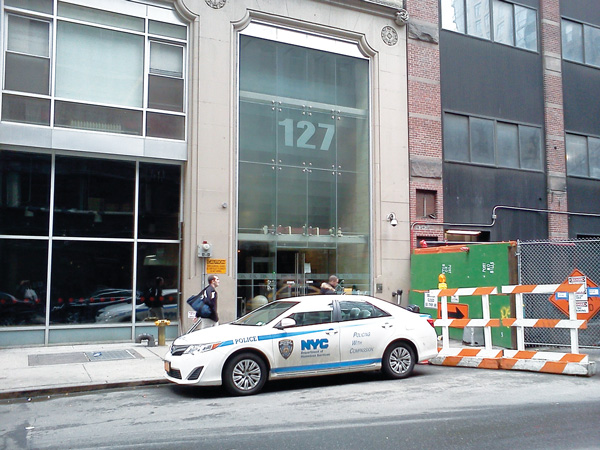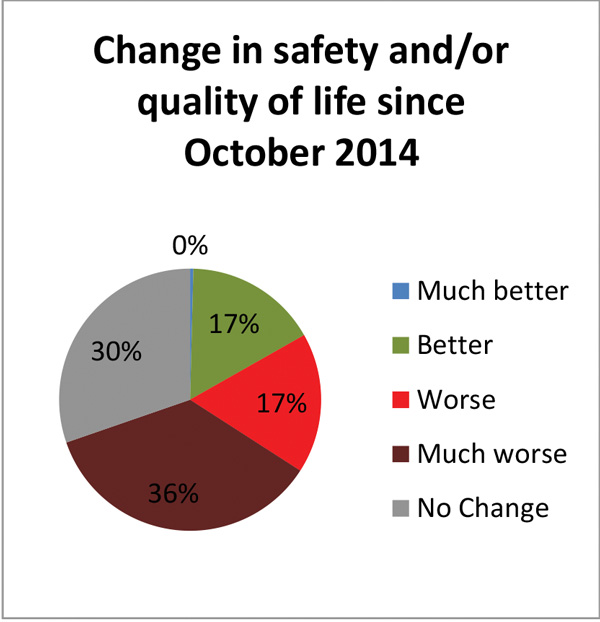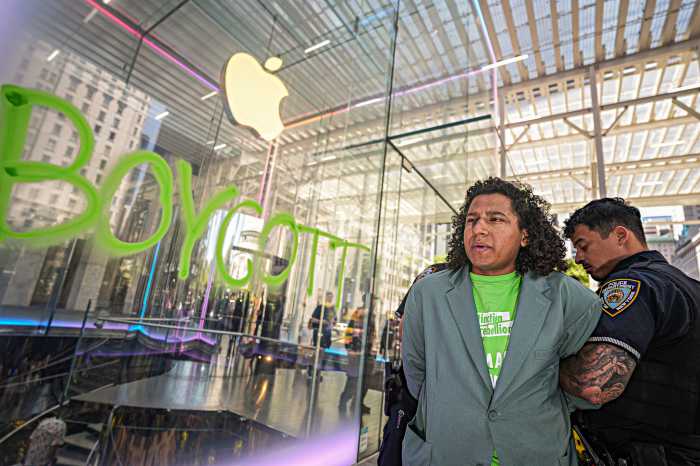
Although peace officers no longer patrol the BRC block, a survey indicates conditions have improved (the DHS maintains a 24-7 presence within the facility).
BY DUSICA SUE MALESEVIC | Since the Bowery Residents’ Committee (BRC) opened its 12-story vertical campus in 2011, relations between the residential and outpatient shelter/treatment facility and its neighbors have been contentious — but a just-released survey links recent efforts to improvements on the block.
Last October, the Department of Homeless Services (DHS) assigned peace officers to patrol W. 25th St. (btw. Sixth & Seventh Aves.). They are trained in security measures but do not carry weapons. After two NYPD officers were fatally shot in Bedford-Stuyvesant in December, the peace officers were pulled off the street (but maintain their 24-7 presence within the facility).
Carla Nordstrom of the West 25th Street Project said that her block association fought hard to get the DHS peace officers to patrol the block.
“Our sense of it was that things became better on the block once they were out patrolling,” said Nordstrom in a phone interview. “But we wanted to be able to show that was the case.”
Muzzy Rosenblatt, executive director for the BRC, explained there are Community Advisory Committee meetings every month. At the December meeting, the idea of doing a survey was discussed, said Rosenblatt.
There was “a desire to get a sense of have [the peace officers] had an impact. Has it changed the mood, the feeling that people have on the block,” he said.
The BRC, Community Board 4, the West 25th Street Project and the offices of Manhattan Borough President Gale Brewer, Assemblymember Richard Gottfried, State Senator Brad Hoylman and Councilmember Corey Johnson worked together on the survey.
In early January, the West 25th Street Project distributed surveys to about 160 people — residents and businesses, she said — with a request to respond by the end of the month. Businesses on the block were asked to reach out to their regular customers.
“We expected that we’d maybe get 100 responses, so we were really pleased when we got as many responses as we did,” said Nordstrom.
A report — “Results of the Com-munity Survey Assessing Safety and Quality of Life Issues in the Area around West 25th Street” — was released last week. Out of the 208 responses, 35 percent of the responses came from residents of the neighborhood, 21 percent came from people who work in the area and 45 percent came from frequent visitors of the neighborhood.
When asked why 45 percent of the respondents came from frequent visitors, Johnson’s office replied in an email that they wanted to include both residents and businesses in the survey. Visitors may have included employees of the businesses on the block.
The survey showed that people feel there has been a deterioration in safety and quality of life since 2011, which is when the BRC moved to W. 25th St. Some examples of how quality of life has changed on the block include harassment toward residents (especially women), a noticeable increase in drug dealing, and more fights reported in the area, according to the survey.
Respondents also said that the presence of DHS peace officers on the block has been helpful. However, many said that they feel less safe during the evening, generally from 4 p.m. to 9 p.m., according to the survey.
“My group was very pleased with the survey because it basically said all of the things that we’ve been saying,” said Nordstrom.

One reason for conducting the survey was, according to Nordstrom, the removal of the peace officers from patrol last December. “We wanted to show that we wanted them back out on the street,” she said, noting however that the bitter cold of January and February reduced foot traffic on the block. “Now,” she observed, “we’re starting to see more street action happening.”
Nordstrom and Rosenblatt both said when the DHS peace officers stopped patrolling in December, that the BRC staff started.
“At the same time, BRC doubled our efforts of having our staff out on the street. Our staff [does] rounds on the block for about 16 hours a day, starting at about 8 o’clock in the morning until our curfew, so about 14 hours a day, ’til about 10 p.m.,” said Rosenblatt. “Our response [was] … if the peace officers couldn’t be out there, we would be out there.”
The BRC staff has been working with the 13th Precinct.
“The 13th Precinct has really made a great effort, both in uniform and undercover, to address some of the real — but also the perceived but not necessarily substantiated — challenges on the block,” said Rosenblatt.
Nordstrom said the BRC staff “were very good at patrolling the block” and that she would like to see the continuation of police involvement.
“We’ve seen much more police presence on the block — that seems to have settled things down,” she said.
When the DHS officers were out on our block, said Nordstrom, they noticed that many of the problems traveled to other blocks and “on 28th Sreet and 27th Street, they were starting to see more challenging behavior.”
Nordstrom said that the block association’s position has always been “to come up with better ways of resolving it,” rather than pass the problem on.
The survey made several recommendations, which included an increase in police officers or peace officers, better lighting on the block, moving the BRC facility from the neighborhood, reducing the number of beds in the shelter and installing security cameras in hotspot areas.
Johnson’s office said that it has been strongly advocating for an NYPD security camera at W. 25th and Sixth Ave. — identified as a hotspot in the survey. The councilmember’s staff has met with the NYPD on that corner to assess the feasibility at this location, and have been discussing this with relevant city agencies, according to his office.
Security cameras would be great, said Bill Borock, president of the Council of Chelsea Block Associations, as it would be wonderful in terms of capturing suspicious activity. He said that the survey was a good thing to do and that it can now be used as a tool.
The BRC has agreed to establish a dedicated phone line so when people see situations on the street, they can call the shelter directly, said Nordstrom.
Rosenblatt said that the survey is a starting point and it can show where things are working and where there is more to be done.
It is unclear if the DHS peace officers will be back anytime soon patrolling the block. DHS did not respond to Chelsea Now’s questions about when they will be back.
However, Councilmember Johnson has secured funding to keep the DHS peace officers at the BRC facility. His office said that they are planning on doing another survey in a few months.
Nordstrom said that the goal of the West 25th Street Project has always been to make the block beautiful, clean and safe for everybody. She said that there are several upcoming events to ensure that, including a Parks Department workshop on tree stewardship. She said that they are trying to build trust and community on the block, including with the BRC residents “so we become better neighbors to each other.”
She said that they have really come a long way.
“It’s feeling very exiting right now,” she said.






























